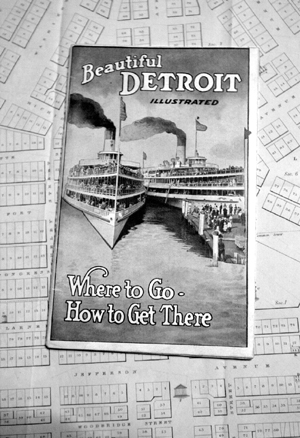By Joanne Nesbit
News and Information Services

The Clements Library has mounted an exhibition that focuses on four events or trends in the 300-year history of Detroit. Featured are artifacts relating to Pontiac’s siege of the British garrison in 1763, the transfer of Detroit from British to U.S. control between 1783 and 1796, William Hull’s humiliating defeat in the first summer of the War of 1812, and the city’s rise to pre-automotive prosperity during the 19th century.
“Detroit’s 300 Years: Four Landmarks in the Collections of the William L. Clements Library” contains a myriad of artifacts, including early maps, licenses issued to the original Detroit traders, drawings, engravings, letters, pamphlets and sheet music. Text accompanying the artifacts presents a chronological history of the city.
From the landing of Antoine Laumet de Lamothe Cadillac through a six-month blockade of the garrison in 1763 by Pontiac, diplomacy with the Native Americans, life as a British stronghold throughout the American Revolution, the Battle of Fallen Timbers, treaties and trading, the exhibition follows the history and growth of Detroit.
“Groups interested in Michigan’s past were active in Detroit as early as the 1820s,” says Brian Leigh Dunnigan, the exhibition’s curator. “Works such as Robert Roberts’ Sketches of the City of Detroit (1855) drew attention to the fact that Detroit was already an old and historic place.”
From its beginning, Detroit took advantage of its location with good water transportation, which became increasingly efficient with the introduction of steamships to the upper Great Lakes in 1818 and made Detroit the chief port of Michigan. The railroads came in 1838, and by 1850, busy wharves and the massive roundhouse of the Michigan Central Railroad dominated the waterfront.
“Eber B. Ward was one of those who took advantage of Detroit’s convenient location to develop shipping and industrial interests,” Dunnigan says. “He promoted improvements, such as the locks at Sault Ste. Marie, and pioneered steel ships and steel making. His efforts made him Detroit’s first millionaire.”
During and after the Civil War, Detroit became an important manufacturing center on the Great Lakes, with ships, copper and brass, stoves, and railroad cars among its chief products.
One of the city’s lighter industries was the publication of sheet music.
“The turn of the 20th century marked the city’s bicentennial, creating an enthusiasm in 1901 that did much to renew interest in Cadillac, other French explorers, and important personalities and events of the 18th and early 19th centuries,” Dunnigan says. “The next year, Henry Ford’s automobiles began putting Detroit on the map for putting the world on wheels.”
The exhibition will continue through Sept. 28 and is open weekdays 1–4:45 p.m. Admission is free.

